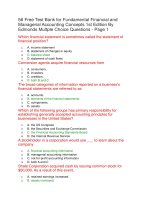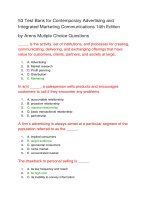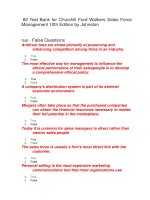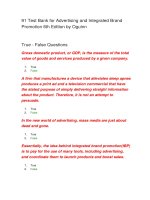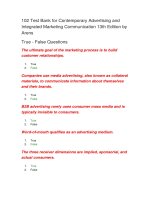Test bank for contemporary advertising and integrated marketing communications 14th edition by arens weigold
Bạn đang xem bản rút gọn của tài liệu. Xem và tải ngay bản đầy đủ của tài liệu tại đây (509.98 KB, 73 trang )
Test Bank for Contemporary Advertising and Integrated Marketing Communications 14th
edition by William Arens, Michael Weigold, Christian Arens
Link full download test bank: />Link full download solution manual: />
Chapter 02 The Big Picture: The Evolution of IMC Answer Key
True / False Questions
1.
(p.
34)
Economics has created the need for advertising and has made it a staple of the free enterprise system.
TRUE
Economics has created the need for advertising and has made it a staple of the free enterprise system.
AACSB:
Analytic Blooms:
Remember
Difficulty: 1 Easy
Learning Objective: 02-01 Explain the role of competition in free-market
economics. Topic: Economics: The Functions of Advertising and
IMC in Free Markets
2.
A market economy is characterized by two assumptions: the interest of the community and the presence
(p.
35)
of externalities.
FALSE
A market economy is characterized by four assumptions: self-interest, complete information, many buyers
and sellers, and absence of externalities (social costs).
AACSB:
Analytic Blooms:
Remember
Difficulty: 1 Easy
Learning Objective: 02-01 Explain the role of competition in free-market economics.
Topic: Principles of Free-Market Economics
2-1
© 2013 by McGraw-Hill Education. This is proprietary material solely for authorized instructor use. Not authorized for sale or distribution in
any manner. This document may not be copied, scanned, duplicated, forwarded, distributed, or posted on a website, in whole or part.
3.
Open competition between self-interested sellers advertising to self-interested buyers leads to greater product
(p.
35)
availability at more competitive prices.
TRUE
Open competition between self-interested sellers advertising to self-interested buyers naturally leads to
greater product availability at more competitive prices.
AACSB:
Analytic Blooms:
Remember
Difficulty: 1 Easy
Learning Objective: 02-01 Explain the role of competition in free-market economics.
Topic: Principles of Free-Market Economics
4.
The sale or consumption of products rarely benefits or harms other people who are not involved in the
(p.
35)
transaction and who did not pay for the product.
FALSE
Sometimes the sale or consumption of products may benefit or harm other people who are not involved in
the transaction and did not pay for the product.
AACSB:
Analytic Blooms:
Remember
Difficulty: 1 Easy
Learning Objective: 02-01 Explain the role of competition in free-market economics.
Topic: Principles of Free-Market Economics
2-2
© 2013 by McGraw-Hill Education. This is proprietary material solely for authorized instructor use. Not authorized for sale or distribution in
any manner. This document may not be copied, scanned, duplicated, forwarded, distributed, or posted on a website, in whole or part.
5.
The assumptions characterizing a market economy describe an ideal economy, not one that actually
(p.
35)
exists.
TRUE
The four assumptions of self-interest, complete information, many buyers and sellers, and absence of
externalities, that characterize a market economy describe an ideal economy, not one that actually exists.
AACSB:
Analytic Blooms:
Remember
Difficulty: 1 Easy
Learning Objective: 02-01 Explain the role of competition in free-market economics.
Topic: Principles of Free-Market Economics
6.
(p.
37)
The most significant function of advertising is to lower the overall cost of sales.
TRUE
The most significant function of advertising is to lower the overall cost of sales.
AACSB:
Analytic Blooms:
Remember
Difficulty: 1 Easy
Learning Objective: 02-02 Discuss the functions advertising performs in a free
market. Topic: Functions and Effects of Advertising in a
Free Economy
2-3
© 2013 by McGraw-Hill Education. This is proprietary material solely for authorized instructor use. Not authorized for sale or distribution in
any manner. This document may not be copied, scanned, duplicated, forwarded, distributed, or posted on a website, in whole or part.
7.
In a free-market economy, when one company starts making significant profits, other companies
(p.
37)
immediately jump in to compete.
TRUE
In a free-market economy, when one company starts to make significant profits, other
companies immediately jump in to compete.
AACSB:
Analytic Blooms:
Remember
Difficulty: 1 Easy
Learning Objective: 02-02 Discuss the functions advertising performs in a free
market. Topic: Functions and Effects of Advertising in a
Free Economy
8.
(p.
38)
Messages aimed to encourage trade were unheard of in pre-industrial societies.
FALSE
Thousands of years ago, most human effort was devoted to meeting basic survival needs: food, clothing,
and shelter. There were no mass media available for possible advertisers to use.
Nevertheless, archaeologists have found evidence of messages meant to encourage trade among
the Babylonians dating back as far as 3000 BC.
AACSB:
Analytic
Blooms:
Remember
Difficulty:2
Medium
Learning Objective: 02-04 Identify important milestones in the history of
advertising
Topic: The Evolution of Advertising as an Economic
Tool
2-4
© 2013 by McGraw-Hill Education. This is proprietary material solely for authorized instructor use. Not authorized for sale or distribution in
any manner. This document may not be copied, scanned, duplicated, forwarded, distributed, or posted on a website, in whole or part.
9.
(p.
44)
Benjamin Franklin was the first American known to use illustrations in ads.
TRUE
Benjamin Franklin was the first American known to use illustrations in ads.
AACSB:
Analytic Blooms:
Remember
Difficulty: 1 Easy
Learning Objective: 02-04 Identify important milestones in the history of advertising.
Topic: The Evolution of Advertising as an Economic Tool
10.
The emergence of urban markets following the Industrial Revolution hindered the growth of
(p.
44)
advertising.
FALSE
In the mid-1700s, the Industrial Revolution began in England, and by the early 1800s it had reached North
America. As people left the farm to work in the city, mass urban markets began to emerge, further fueling
market development and the growth of advertising.
AACSB:
Analytic Blooms:
Remember
Difficulty: 1 Easy
Learning Objective: 02-04 Identify important milestones in the history of advertising.
Topic: The Evolution of Advertising as an Economic Too
2-5
© 2013 by McGraw-Hill Education. This is proprietary material solely for authorized instructor use. Not authorized for sale or distribution in
any manner. This document may not be copied, scanned, duplicated, forwarded, distributed, or posted on a website, in whole or part.
11.
(p.
44)
The advertising industry existed before the industrial age.
FALSE
Ads were created prior to the industrial age, but it was not until this period that it can be said that an
advertising industry existed anywhere in the world.
AACSB:
Analytic Blooms:
Remember
Difficulty: 1 Easy
Learning Objective: 02-04 Identify important milestones in the history of advertising.
Topic: The Evolution of Advertising as an Economic Tool
12.
The American profession of advertising began when Volney B. Palmer set up business in
(p.
46)
Philadelphia in 1841.
TRUE
The American profession of advertising began when Volney B. Palmer set up business in
Philadelphia in 1841.
AACSB:
Analytic Blooms:
Remember
Difficulty: 1 Easy
Learning Objective: 02-04 Identify important milestones in the history of advertising.
Topic: The Industrial Age and the Birth of Ad Agencies
2-6
© 2013 by McGraw-Hill Education. This is proprietary material solely for authorized instructor use. Not authorized for sale or distribution in
any manner. This document may not be copied, scanned, duplicated, forwarded, distributed, or posted on a website, in whole or part.
13.
(p.
46)
A. C. Nielsen produced the earliest catalogs, bringing a wide variety of products to new, rural markets.
FALSE
Mongomery Ward and Sears Roebuck produced the earliest catalogs, bringing a wide variety of products
to new, rural markets.
AACSB:
Analytic Blooms:
Remember
Difficulty: 1 Easy
Learning Objective: 02-04 Identify important milestones in the history of advertising.
Topic: The Industrial Age and the Birth of Ad Agencies
14.
A vodka company using the slogan "Spirit for the Spirited" in order to enhance the appeal of its brand is using
(p.
46)
product differentiation.
TRUE
Manufacturers follow the strategy of product differentiation, seeking to portray their brands as different from
and better than the competition by offering consumers quality, variety, and convenience.
AACSB:
Reflective Thinking
Blooms:
Understand
Difficulty:
2
Medium
Learning Objective: 02-04 Identify important milestones in the history of
advertising.
Topic: The Industrial Age and the Birth of Ad
Agencies
2-7
© 2013 by McGraw-Hill Education. This is proprietary material solely for authorized instructor use. Not authorized for sale or distribution in
any manner. This document may not be copied, scanned, duplicated, forwarded, distributed, or posted on a website, in whole or part.
15.
(p.
47)
A product's unique selling point is a feature that differentiates it from competitive products.
TRUE
Rosser Reeves of the Ted Bates Agency introduced the idea that every ad must point out the product’s
USP (unique selling proposition) — features that differentiate it from competitive products.
AACSB:
Analytic Blooms:
Remember
Difficulty: 1 Easy
Learning Objective: 02-04 Identify important milestones in the history of advertising.
Topic: The Golden Age of Advertising
16.
Market segmentation is a process by which manufacturers seek to portray their brands as different
(p.
48)
from and better than the competition by offering consumers quality, variety, and convenience.
FALSE
Market segmentation is a process by which marketers searched for unique groups of people whose needs
could be addressed through more specialized products.
AACSB:
Analytic Blooms:
Remember
Difficulty: 1 Easy
Learning Objective: 02-04 Identify important milestones in the history of advertising.
Topic: The Golden Age of Advertising
2-8
© 2013 by McGraw-Hill Education. This is proprietary material solely for authorized instructor use. Not authorized for sale or distribution in
any manner. This document may not be copied, scanned, duplicated, forwarded, distributed, or posted on a website, in whole or part.
17.
Demarketing is used by marketers primarily to identify unique groups of people whose needs can be
(p.
49)
addressed through more specialized products.
FALSE
Demarketing is used to dampen demand for products, especially those that create unwanted costs for
society.
AACSB:
Analytic Blooms:
Remember
Difficulty: 1 Easy
Learning Objective: 02-04 Identify important milestones in the history of advertising.
Topic: The Postindustrial Age
18.
A megamerger occurs when big multinational companies buy other big companies in order to expand
(p.
49)
globally.
TRUE
To expand globally, big multinational companies and their advertising agencies went on a binge during the
postindustrial age, buying other big companies and creating a new word in the financial lexicon:
megamerger.
AACSB:
Analytic
Blooms:
Remember
Difficulty:
2
Medium
Learning Objective: 02-04 Identify important milestones in the history of advertising.
Topic: The Postindustrial Age
2-9
© 2013 by McGraw-Hill Education. This is proprietary material solely for authorized instructor use. Not authorized for sale or distribution in
any manner. This document may not be copied, scanned, duplicated, forwarded, distributed, or posted on a website, in whole or part.
19.
(p.
49)
Beginning around 1980, the postindustrial age has been a period of relative stability.
FALSE
Beginning around 1980, the postindustrial age has been a period of cataclysmic change.
AACSB:
Analytic Blooms:
Remember
Difficulty: 1 Easy
Learning Objective: 02-04 Identify important milestones in the history of advertising.
Topic: The Postindustrial Age
20.
The marketing world of the postindustrial age was characterized by competition intensified by lower trade
(p.
49)
barriers and growing international trade.
TRUE
The most important economic factor that characterized the marketing world of the postindustrial age
was competition, intensified by lower trade barriers and growing international trade.
AACSB:
Analytic Blooms:
Remember
Difficulty: 1 Easy
Learning Objective: 02-04 Identify important milestones in the history of advertising.
Topic: The Postindustrial Age
2-10
© 2013 by McGraw-Hill Education. This is proprietary material solely for authorized instructor use. Not authorized for sale or distribution in
any manner. This document may not be copied, scanned, duplicated, forwarded, distributed, or posted on a website, in whole or part.
21.
Larry Page and Sergey Brin developed AdWords, an advertising program, that eventually generated billions
(p.
51)
in profits.
TRUE
Larry Page and Sergey Brin, two Stanford grad students, developed AdWords, an advertising program for
their search engine, Google, that eventually generated billions in profits.
AACSB:
Analytic Blooms:
Remember
Difficulty: 1 Easy
Learning Objective: 02-04 Identify important milestones in the history of advertising.
Topic: The Postindustrial Age
22.
The importance of advertising in individual countries depends on the country’s level of
(p.
51)
development and national attitude toward promotion.
TRUE
The importance of advertising in individual countries depends on the country’s level of development
and national attitude toward promotion. Typically, advertising expenditures are higher in countries with
higher personal incomes.
AACSB:
Analytic Blooms:
Remember
Difficulty: 1 Easy
Learning Objective: 02-05 Discuss how the role of advertising has changed in recent years.
Topic: The Global Interactive Age: Looking at the 21st Century
2-11
© 2013 by McGraw-Hill Education. This is proprietary material solely for authorized instructor use. Not authorized for sale or distribution in
any manner. This document may not be copied, scanned, duplicated, forwarded, distributed, or posted on a website, in whole or part.
23.
Small companies and product marketers that appeal to a limited clientele use TV to reach audiences with
(p.
52)
unique interests.
TRUE
Small companies and product marketers that appeal to a limited clientele use TV to reach audiences with
unique interests.
AACSB:
Analytic Blooms:
Remember
Difficulty: 1 Easy
Learning Objective: 02-05 Discuss how the role of advertising has changed in recent years.
Topic: The Global Interactive Age: Looking at the 21st Century
24.
Advertising has been a major factor in improving the standard of living in the United States and around the
(p.
54)
world.
TRUE
Advertising has been a major factor in improving the standard of living in the United States and around the
world.
AACSB:
Analytic Blooms:
Remember
Difficulty: 1 Easy
Learning Objective: 02-06 Explore the impact of advertising on society yesterday, today, and tomorrow.
Topic: Society and Ethics: The Effects of Advertising
2-12
© 2013 by McGraw-Hill Education. This is proprietary material solely for authorized instructor use. Not authorized for sale or distribution in
any manner. This document may not be copied, scanned, duplicated, forwarded, distributed, or posted on a website, in whole or part.
25.
(p.
57)
Advertising helps create personalities for products in the market.
TRUE
You can also make a statement about yourself as an individual with the vehicle you purchase. As with many
products, advertising has created a personality for each automobile model on the market.
AACSB:
Analytic Blooms:
Remember
Difficulty: 1 Easy
Learning Objective: 02-06 Explore the impact of advertising on society yesterday, today, and tomorrow.
Topic: Society and Ethics: The Effects of Advertising
Multiple Choice Questions
26.
Which of the following is an assumption that characterizes a free-market economy?
(p.
35)
A. Presence of externalities
B. Few buyers and sellers
C. Self-interest
D. Greater involvement of the government
E. Emphasis on communal goals
A market economy is characterized by four assumptions: self-interest, complete information, many
buyers and sellers, and absence of externalities (social costs).
AACSB:
Analytic Blooms:
Remember
Difficulty: 1 Easy
Learning Objective: 02-01 Explain the role of competition in freemarket
economics.
Topic: Principles of Free-Market Economics
2-13
© 2013 by McGraw-Hill Education. This is proprietary material solely for authorized instructor use. Not authorized for sale or distribution in
any manner. This document may not be copied, scanned, duplicated, forwarded, distributed, or posted on a website, in whole or part.
27.
Which of the following is true of a market economy?
(p.
35)
A. The government determines what and how much is produced and consumed.
B. Firms and households rarely interact in the marketplace.
C. Open competition between self-interested sellers advertising to self-interested buyers adversely
affects product availability.
D. The role of information is negligible with regard to buying decisions.
E. People and firms pursue their own goals.
AACSB:
Analytic Blooms:
Remember
Difficulty: 1 Easy
Learning Objective: 02-01 Explain the role of competition in free-market economics.
Topic: Principles of Free-Market Economics
28.
Which of the following refers to an externality associated with the purchase of firearms?
(p.
35)
A. An increase in the rate of crime
B. An increase in the popularity of shooting sports
C. Easy availability of cheap, after-sales service of firearms
D. Enhanced personal security
E. An increase in exports of firearms
Externalities are social costs that are the result of a purchase. Sometimes the sale or consumption products
may benefit or harm other people who are not involved in the transaction and didn’t pay for the product.
AACSB:
AnalyticBlooms
Understand:
Difficulty: 2 Medium
Learning Objective: 02-01 Explain the role of competition in free-market economics.
Topic: Principles of Free-Market Economics
2-14
© 2013 by McGraw-Hill Education. This is proprietary material solely for authorized instructor use. Not authorized for sale or distribution in
any manner. This document may not be copied, scanned, duplicated, forwarded, distributed, or posted on a website, in whole or part.
29.
Which of the following functions does advertising serve as a marketing tool?
(p.
36)
A. Withhold information about products and the place of sale
B. Discourage reuse of products
C. Increase the overall cost of sales
D. Increase the use of products
E. Create and sustain market monopolies
The functions and effects of advertising as a marketing tool are: to identify products and differentiate
them from others, to communicate information about the product, its features, and its place of sale, to induce
consumers to try new products and to suggest reuse, to stimulate the distribution of a product, to increase
product use, to build value, brand preference, and loyalty, and to lower the overall cost of sales.
AACSB:
Analytic Blooms:
Remember
Difficulty: 1 Easy
Learning Objective: 02-02 Discuss the functions advertising performs in a free
market Topic: Functions and Effects of Advertising in a
Free Economy
2-15
© 2013 by McGraw-Hill Education. This is proprietary material solely for authorized instructor use. Not authorized for sale or distribution in
any manner. This document may not be copied, scanned, duplicated, forwarded, distributed, or posted on a website, in whole or part.
30.
Which of the following is a basic function of branding?
(p.
35)
A. To ensure that all products are offered at everyday low prices
B. To identify products and differentiate them from others
C. To dampen the demand for unwanted products
D. To search for unique groups of people with special product needs
E. To impede the distribution of products
The most basic function of branding as well as advertising is to identify products and their source and to
differentiate them from others.
AACSB:
Analytic Blooms:
Remember
Difficulty: 1 Easy
Learning Objective: 02-02 Discuss the functions advertising performs in a free
market. Topic: Functions and Effects of Advertising in a
Free Economy
2-16
© 2013 by McGraw-Hill Education. This is proprietary material solely for authorized instructor use. Not authorized for sale or distribution in
any manner. This document may not be copied, scanned, duplicated, forwarded, distributed, or posted on a website, in whole or part.
31.
Which of the following is a benefit provided to a company by strong brands?
(p.
38)
A. They tend to trigger price wars.
B. They eliminate the chance of failure for new products completely.
C. They garner consumer loyalty.
D. They encourage customers to choose products from different companies.
E. They ensure uniform pricing versus competitors.
The benefits provided to a company by strong brands are these: they allow for premium pricing versus
competitors, they afford protection against price wars, they allow for a greater chance a new product will
succeed, they afford leverage in negotiating with channel partners, they make companies more attractive to cobranding partners, they help companies more effectively deal with a brand crisis, they help companies recruit
top talent, and they garner consumer loyalty.
AACSB:
Analytic Blooms:
Remember
Difficulty: 1 Easy
Learning Objective: 02-03 Understand the importance of branding, including the benefits that strong brands offer
companies.
Topic: The Brand
2-17
© 2013 by McGraw-Hill Education. This is proprietary material solely for authorized instructor use. Not authorized for sale or distribution in
any manner. This document may not be copied, scanned, duplicated, forwarded, distributed, or posted on a website, in whole or part.
32.
During the
(p.
44)
Germany.
, the Chinese invented paper and Gutenberg invented the printing press in
A. preindustrial age
B. Industrial Revolution
C. information revolution
D. industrial age
E. postindustrial age
During the preindustrial age, several important events contributed to the eventual development of modern
advertising. The Chinese invented paper and Europe had its first paper mill by 1275. Around 1439,
Johannes Gutenberg invented the printing press in Germany.
AACSB:
Analytic
Difficulty: 1
Easy
Learning Objective: 02-04 Identify important milestones in the history of advertising.
Topic: Early Advertising
33.
Until the advent of public schooling in America, many advertisements took the form of signs with symbols,
(p.
44)
such as a beer tankard indicating a tavern, because:
A. most people were illiterate and could not read.
B. the advertisers could not afford to produce sophisticated advertisements.
C. there were laws prohibiting advertising in newspapers and handbills.
D. the Church would not approve of any other form of advertising.
E. such advertisements promoted puffery.
Until the advent of public schooling, most people couldn’t read—so signs featured symbols of the goods or
services for sale.
AACSB: Analytic
2-18
© 2013 by McGraw-Hill Education. This is proprietary material solely for authorized instructor use. Not authorized for sale or distribution in
any manner. This document may not be copied, scanned, duplicated, forwarded, distributed, or posted on a website, in whole or part.
Blooms:
Remember Learning Objective: 02-04 Identify important milestones in the
history of advertising.
Topic: Early Advertising
34.
Which famous English literary figure's observation that advertisements were so numerous that they were
(p.
44)
“negligently perused” and that it had become necessary to gain attention “by magnificence of
promise”, led to the beginning of puffery in advertising?
A. Samuel Pepys
B. Nicholas Rowe
C. William Congreve
D. John Dennis
E. Samuel Johnson
Samuel Johnson, a famous English literary figure, observed in 1758 that advertisements were now so
numerous that they were “negligently perused” and that it had become necessary to gain attention “by
magnificence of promise.” This was the beginning of puffery in advertising.
AACSB:
Analytic Blooms:
Remember
Difficulty: 1 Easy
Learning Objective: 02-04 Identify important milestones in the history of advertising.
Topic: Early Advertising
2-19
© 2013 by McGraw-Hill Education. This is proprietary material solely for authorized instructor use. Not authorized for sale or distribution in
any manner. This document may not be copied, scanned, duplicated, forwarded, distributed, or posted on a website, in whole or part.
35.
Which of the following products was advertised in the first ad in English that appeared in 1472?
(p.
44)
A. A plow
B. A farm animal
C. A prayer book
D. A religious service
E. A country tavern
In 1472, the first ad in English appeared: a handbill tacked on church doors in London
announcing a prayer book for sale.
AACSB:
Analytic Blooms:
Remember
Difficulty: 1 Easy
Learning Objective: 02-04 Identify important milestones in the history of advertising.
Topic: Early Advertising
36.
In the context of early advertising, the invention of the
(p.
44)
handbills, and signs possible.
made advertising via posters,
A. quill pen
B. printing press
C. silk screen
D. lead molding machine
E. steam engine
The printing press made possible the early instances of advertising—posters, handbills, and signs—
and, eventually, the first mass medium—the newspaper.
AACSB: Analytic
Difficulty: 1
Easy
2-20
© 2013 by McGraw-Hill Education. This is proprietary material solely for authorized instructor use. Not authorized for sale or distribution in
any manner. This document may not be copied, scanned, duplicated, forwarded, distributed, or posted on a website, in whole or part.
Learning Objective: 02-04 Identify important milestones in the history of advertising.
Topic: Early Advertising
37.
In the industrial age, fresh mass markets developed for new and inexpensive brands of luxury and
(p.
44)
convenience goods called
.
A. pure public goods
B. business goods
C. consumer packaged goods
D. intermediate goods
E. common goods
As the U.S. industry met the basic needs of most of the population, commodity markets became saturated.
Fresh mass markets then developed for the new, inexpensive brands of consumer luxury and
convenience goods called consumer packaged goods.
AACSB:
Analytic Blooms:
Remember
Difficulty: 1 Easy
Learning Objective: 02-04 Identify important milestones in the history of advertising.
Topic: The Industrial Age and the Birth of Ad Agencies
2-21
© 2013 by McGraw-Hill Education. This is proprietary material solely for authorized instructor use. Not authorized for sale or distribution in
any manner. This document may not be copied, scanned, duplicated, forwarded, distributed, or posted on a website, in whole or part.
38.
Who among the following is regarded as the father of advertising art and was the first American known to use
(p.
44)
illustrations in ads?
A. Benjamin Franklin
B. Johannes Gutenberg
C. Samuel Johnson
D. Samuel Pepys
E. Marcel Bleustein-Blanchet
Benjamin Franklin, the father of advertising art, made ads more readable by using large headlines and
considerable white space. In fact, Franklin was the first American known to use illustrations in ads.
AACSB:
Analytic Blooms:
Remember
Difficulty: 1 Easy
Learning Objective: 02-04 Identify important milestones in the history of advertising.
Topic: Early Advertising
2-22
© 2013 by McGraw-Hill Education. This is proprietary material solely for authorized instructor use. Not authorized for sale or distribution in
any manner. This document may not be copied, scanned, duplicated, forwarded, distributed, or posted on a website, in whole or part.
39.
An ad in a fitness magazine offered a 30-day, free, at-home trial of an exercise bicycle with free shipping,
(p.
36)
and the option of returning the bicycle if the customer was not satisfied with it. The primary function of the
ad was to:
A. control competitive pricing practices.
B. establish exclusive distribution rights for the bicycle.
C. communicate the company's quality mission.
D. induce consumers to try the bicycle.
E. communicate information about the bicycle's after-sale service.
One of the functions and effects of using advertising as a marketing tool is to induce customers to try new
products and to suggest reuse.
AACSB:
Reflective
Thinking
Blooms:
Understand
Difficulty:
2
Medium
Learning Objective: 02-02 Discuss the functions advertising performs in a free
market. Topic: Functions and Effects of Advertising in a Free
Economy
40.
The industrial age started during:
(p.
44)
A. the second half of the 16th century.
B. the second half of the 15th century.
C. the second half of the 19th century.
D. the second half of the 20th century.
E. the second half of the 17th century.
The industrial age started during the second half of the 19th century and lasted well into the 20th century.
AACSB: Analytic
2-23
© 2013 by McGraw-Hill Education. This is proprietary material solely for authorized instructor use. Not authorized for sale or distribution in
any manner. This document may not be copied, scanned, duplicated, forwarded, distributed, or posted on a website, in whole or part.
Blooms:
Remember
Difficulty: 1
Easy
Learning Objective: 02-04 Identify important milestones in the history of advertising.
Topic: The Industrial Age and the Birth of Ad Agencies
41.
Which of the following statements most accurately describes the role of manufacturers during the 1800s?
(p.
45)
A. Manufacturers were responsible for marketing their products.
B. Manufacturers stimulated consumer demand through mass media advertising.
C. Manufacturers were primarily responsible for keeping retailers informed about the sources of supply and
shipping schedules for commodities.
D. Manufacturers were principally concerned with production.
E. Manufacturers were principally concerned with segmenting markets for their products.
During the 1800s, manufacturers were principally concerned with production. The burden of marketing fell on
wholesalers, who used advertising primarily as an information vehicle. Ads appeared in publications called
price currents that informed retailers about the sources of supply and shipping schedules for
commodities.
AACSB:
Analytic Blooms:
Remember
Difficulty: 1 Easy
Learning Objective: 02-04 Identify important milestones in the history of advertising.
Topic: The Industrial Age and the Birth of Ad Agencies
2-24
© 2013 by McGraw-Hill Education. This is proprietary material solely for authorized instructor use. Not authorized for sale or distribution in
any manner. This document may not be copied, scanned, duplicated, forwarded, distributed, or posted on a website, in whole or part.
42.
During the 1800s, wholesalers placed ads in publications called
(p.
45)
about the sources of supply and shipping schedules for commodities.
that informed retailers
A. supply currents
B. demand currents
C. price currents
D. puff pieces
E. sales pitches
During the 1800s, manufacturers were principally concerned with production. The burden of marketing fell on
wholesalers, who used advertising primarily as an information vehicle. Ads appeared in publications called
price currents that informed retailers about the sources of supply and shipping schedules for
commodities.
AACSB:
Analytic Blooms:
Remember
Difficulty: 1 Easy
Learning Objective: 02-04 Identify important milestones in the history of advertising.
Topic: The Industrial Age and the Birth of Ad Agencies
2-25
© 2013 by McGraw-Hill Education. This is proprietary material solely for authorized instructor use. Not authorized for sale or distribution in
any manner. This document may not be copied, scanned, duplicated, forwarded, distributed, or posted on a website, in whole or part.
